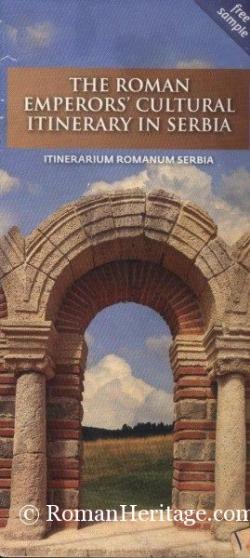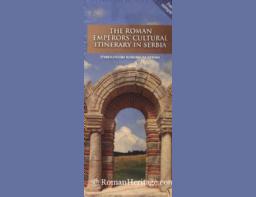RomanHeritage
is a non-profit cultural website about Ancient Rome, with Republican & Imperial Roman sites, roman ruins, Museums, books & movies, re-enactment groups, statues, Mosaics, frescoes, bronzes, etc.
Roman Heritage / Legado Romano
web sin ánimo de lucro sobre el Imperio romano, los yacimientos, ruinas romanas, museos, libros y películas, reconstrucción histórica, estatuas, mosaicos, frescos, etc.
Roman Heritage /Heredité Romaine
c'est une website sur l'empire Romain avec de Ruines romaines, museés, livres et films, groupes de reconstrucion historique, statues, mosaics et frescos.
Serbia Moesia

MOESIA / SERBIA & Bulgaria
Created: 29 BC
Abandoned: 395 AD
Moesia is geographically located in areas close to the Danube in Serbia and Bulgaria today.
First inhabited by Dacian tribes, the population is gradually replaced by various group migrating Moesia Thrace in 500 BC and dominate the whole territory. The Thracians were an ancient Indo-European people made up of several tribes with similar language and way of life but without a common political identity.
However, they have a highly refined culture of oral transmission and believe in the immortality of the soul separated from the body, a completely new idea at the time.
Moesia comprises two very different geographical regions. Based on these differences, Domitian divided the province into two in 85 AD :
Moesia Superior (Moesis Margensis) to the west, is a mountainous area rich in minerals and precious metals. Gold Moesia was a great resource for the minting of coins in the Empire.
Moesia Inferior, in the east, lies on fertile plains where cereals are grown, there are plenty of farms and good pasture for livestock. In 57 A.D. Moesia wheat is included for the first time in Rome's grain imports.
In the provincial reorganization of Diocletian (284-305 AD) the central part of the territory Moesia, between Superior and Moesia Inferior Moesia is declared a new province called Dacia. The reason is that after the administrative evacuation (274 AD) ordered the Dacia by Aurelian founded by Trajan (98-117 AD), many of the settlers abandoned Dacia and settled back into this area of Moesia.
Apart from its agricultural and livestock wealth and abundance of precious metals, Moesia is an important step in the caravan trade network from west to east because of its geographical position between the Danube and Black Sea. And militarily, it can serve as a shield for the Greek provinces against potential invading barbarians.
Thus, the Roman Empire has been interested in this region and in 75 BC, which oath Scribonia, proconsul of Macedonia province, arrives with his army to the Danube. The conquest was not sustained and after other expeditions (44 BC), was completed only in 29 BC with Octavian (Augustus)
However, the native Thracian tribes never became fully Romanized because they were always on the move or the mercy of the barbaric invasions. Culturally they apparently came to speak Latin, with Greek influence in the area. With its economic demands, Rome encouraged agriculture and trade, raising the standard of living in the province and promoted city life.
Precisely because of the continuing threat of Gothic peoples, Moesia always needed the presence of four legions (two in Moesia Superior and two at the bottom). And Rome's military engineers build a complex network of fortifications from the Rhine in Germany (Germany) to the Black Sea.
The poet Ovid, exiled to the city of Tomis in 9 AD and lived there until his death in AD 17, describes how militias were needed to ensure the safety of the farmers as they worked the fields, often besieged by Goths and Germanic tribes.
After the defeat of the Empire at Adrianople (Edirne) in 378 AD, Moesia is devastated by the Visigoths and in 395 AD, the death of Theodosius, Moesia becomes part of the Roman Empire.
Today Mesia (Miziya) is a neighborhood in the city of Pleven (Bulgaria).
ROMAN REMAINS Moesia Superior
SINGIDINUM (Belgrade, Serbia)
Viminacium or AELIUM CITY (Kostolatz, Serbia)
Bononia (Widdin, Bulgaria)
RATIARIA (Artcher, Bulgaria)
ROMAN REMAINS Moesia Inferior
Thomis (Constanta, Romania): Building mosaics (Roman mall three floors), baths, warehouses to store and transport amphorae, Axiópolis wall, sculptures, coins
OESCUS, colony Ulpia (Gigen, Bulgaria)
NOVA (about Sistova, Bulgaria)
Nicopolis ad Istrum (Nikup, Bulgaria)
Odessus (Varna, Bulgaria)
ROMAN REMAINS of Today Serbia Panonia
Acumincum (Slankamen Stari, Serbia)
Bassianae (Donji Petrovci, Serbia)
Bononia (Banostor, Serbia)
Burgunac (Banozci Novi, Serbia)
Cusum (Petrovaradin, Serbia)
Rittium (Surduk, Serbia)
Singidunum (Belgrade, Serbia)
Sirmium (Sremska Mitrovica, Serbia)
Taurunum (Zemun, Serbia)
We have used the guide "The Roman Emperor's cultural itinerary in Serbia" edited by the Serbian Tourism Office, and which image we reproduce here.




